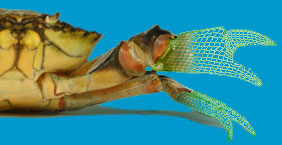Dr. Björn Ch. Ludwar
Associate Professor of Biology
Director Health Pre-Professional Program
Dept. of Biology & Environ. Sciences
Longwood University
Associate Scientist
Fishberg Department of Neuroscience
Friedman Brain Institute
Icahn School of Medicine
Mount Sinai Hospital, New York
![]()
My interests lie at the intersection of biology and information. Trained as a neurobiologist, I have worked and published on topics such as the coordination of hexapod leg movements [1], mechanisms individual neurons employ to control the flow of sensory information to the central nervous system [2], and the information theoretical analysis of analog neural transmission [3]. To explore these topics, I use techniques such as classical electrophysiology, functional imaging [4], electron microscopy, and computational analysis.
One of my current projects is taking my interest in information processing to a practical application: the use of fingerprints to assess a person's risk of suffering from Diabetes Mellitus. Fingerprints develop in the embryo at age 14 to 17 weeks. At this developmental stage genetic and environmental conditions affect the embryo's ability to regulate blood sugar levels and presumably bilateral fingerprint symmetry. Working with my collaborators Dr. Morris from Ohio University and Drs. Shubrook and Young from Touro University CA, I was able to develop patent pending technology to quantify fingerprint asymmetry. In a clinical study we could show a correlation between fingerprint asymmetry and Diabetes Mellitus [5]. We believe that our research could become the basis for new cost-effective diabetes screening technology.
Another project uses 3D image analysis for behavioral tracking of aquatic animals. The experiments employ automated longtime observations (in the order of several days) with multiple cameras and statistical analysis to detect behavioral changes that are e.g. caused by low-dose toxins such as neo-nicotinoid pesticides. The goal is not only to provide students with a genuine research experience, but also to detect the impact of low-dose toxins by identifying subtle behavioral changes that indicate an animal's reduced ability to orient itself and to find food sources and mates.
I teach Human Anatomy & Physiology (BIOL206, BIOL207, BIOL301), Invertebrate Zoology (BIOL495), Entomology (BIOL374),Special Topics Neurobiology (BIOL455, BIOL495), Intro Biology (BIOL101), and the biology capstone (BIOL488).
Selected articles:
[1] Intersegmental coordination of walking movements in stick insects. Ludwar BC, Göritz ML, Schmidt J. J Neurophysiol. 2005 Mar;93(3):1255-65. PMID: 15525808
[2] Activity-dependent increases in [Ca2+]i contribute to digital-analog plasticity at a molluscan synapse. Ludwar BC, Evans CG, Cambi M, Cropper EC., J Neurophysiol. 2017 Jun 1;117(6):2104-2112. doi: 10.1152/jn.00034.2017. Epub 2017 Mar 8. PMID: 28275057
[3] Information rate and spike-timing precision of proprioceptive afferents. DiCaprio RA, Billimoria CP, Ludwar BCh. J Neurophysiol. 2007 Sep;98(3):1706-17. PMID: 17634343
[4] Monitoring changes in the intracellular calcium concentration and synaptic efficacy in the mollusc Aplysia. Ludwar BCh, Evans CG, Cropper EC., J Vis Exp. 2012 Jul 15;(65):e3907. doi: 10.3791/3907. PMID: 22824826
[5] A New Method to Assess Asymmetry in Fingerprints Could Be Used as an Early Indicator of Type 2 Diabetes Mellitus. Morris MR, Ludwar BCh, Swingle E, Mamo MN, Shubrook JH. J Diabetes Sci Technol. 2016 Jun 28;10(4):864-71. doi: 10.1177/1932296816629984. PMID: 26830490
For a more complete list please look at PubMed.

